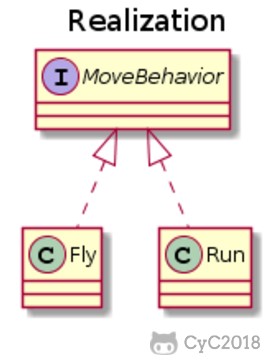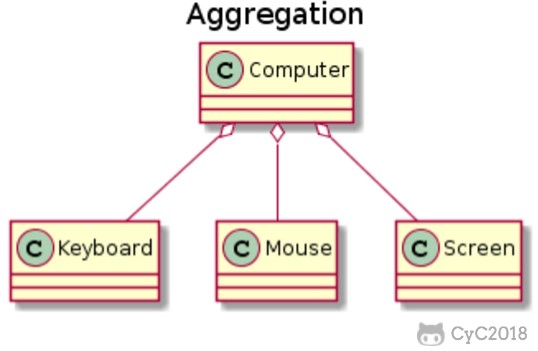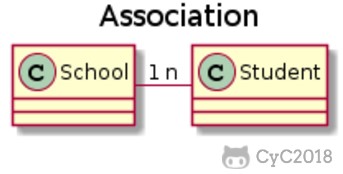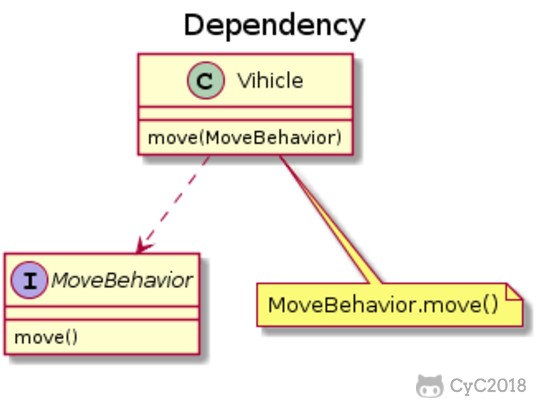一、UML 类图
以下类图使用 PlantUML(opens new window)绘制,更多语法及使用请参考:http://plantuml.com/ 。
泛化关系 (Generalization)
用来描述继承关系,在 Java 中使用 extends 关键字。
@startumltitle Generalizationclass Vihicalclass Carclass TrunckVihical <|-- CarVihical <|-- Trunck@enduml
实现关系 (Realization)
用来实现一个接口,在 Java 中使用 implements 关键字。
@startumltitle Realizationinterface MoveBehaviorclass Flyclass RunMoveBehavior <|.. FlyMoveBehavior <|.. Run@enduml
聚合关系 (Aggregation)
表示整体由部分组成,但是整体和部分不是强依赖的,整体不存在了部分还是会存在。
@startumltitle Aggregationclass Computerclass Keyboardclass Mouseclass ScreenComputer o-- KeyboardComputer o-- MouseComputer o-- Screen@enduml
组合关系 (Composition)
和聚合不同,组合中整体和部分是强依赖的,整体不存在了部分也不存在了。比如公司和部门,公司没了部门就不存在了。但是公司和员工就属于聚合关系了,因为公司没了员工还在。
@startumltitle Compositionclass Companyclass DepartmentAclass DepartmentBCompany *-- DepartmentACompany *-- DepartmentB@enduml
关联关系 (Association)
表示不同类对象之间有关联,这是一种静态关系,与运行过程的状态无关,在最开始就可以确定。因此也可以用 1 对 1、多对 1、多对多这种关联关系来表示。比如学生和学校就是一种关联关系,一个学校可以有很多学生,但是一个学生只属于一个学校,因此这是一种多对一的关系,在运行开始之前就可以确定。
@startumltitle Associationclass Schoolclass StudentSchool "1" - "n" Student@enduml
依赖关系 (Dependency)
和关联关系不同的是,依赖关系是在运行过程中起作用的。A 类和 B 类是依赖关系主要有三种形式:
- A 类是 B 类方法的局部变量;
- A 类是 B 类方法的参数;
- A 类向 B 类发送消息,从而影响 B 类发生变化。

@startumltitle Dependencyclass Vihicle {move(MoveBehavior)}interface MoveBehavior {move()}note "MoveBehavior.move()" as NVihicle ..> MoveBehaviorVihicle .. N@enduml
二、设计原则
S.O.L.I.D
| 简写 | 全拼 | 中文翻译 |
|---|---|---|
| SRP | The Single Responsibility Principle | 单一责任原则 |
| OCP | The Open Closed Principle | 开放封闭原则 |
| LSP | The Liskov Substitution Principle | 里氏替换原则 |
| ISP | The Interface Segregation Principle | 接口分离原则 |
| DIP | The Dependency Inversion Principle | 依赖倒置原则 |
1. 单一责任原则
修改一个类的原因应该只有一个。
换句话说就是让一个类只负责一件事,当这个类需要做过多事情的时候,就需要分解这个类。
如果一个类承担的职责过多,就等于把这些职责耦合在了一起,一个职责的变化可能会削弱这个类完成其它职责的能力。
应用实例
方案1[分析说明]
public class SingleResponsibility1 {public static void main(String[] args) {Vehicle vehicle = new Vehicle();vehicle.run("汽车");vehicle.run("轮船");vehicle.run("飞机");}}/*** 方式1的分析* 1.在方式1的run方法中,违反了单一职责原则* 2.解决的方案非常的简单,根据交通工具运行方法不同,分解成不同类即可*/class Vehicle{public void run(String type){if ("汽车".equals(type)) {System.out.println(type + "在公路上运行...");} else if ("轮船".equals(type)) {System.out.println(type + "在水面上运行...");} else if ("飞机".equals(type)) {System.out.println(type + "在天空上运行...");}}}
方案2[分析说明]
public class SingleResponsibility2 {public static void main(String[] args) {RoadVehicle roadVehicle = new RoadVehicle();roadVehicle.run("汽车");WaterVehicle waterVehicle = new WaterVehicle();waterVehicle.run("轮船");AirVehicle airVehicle = new AirVehicle();airVehicle.run("飞机");}}/*** 方案2的分析* 1.遵守单一职责原则* 2.但是这样做的改动很大,即将类分解,同时修改客户端* 3.改进:直接修改Vehicle类,改动的代码会比较少=>方案3*/class RoadVehicle{public void run(String type){System.out.println(type + "在公路上运行...");}}class WaterVehicle{public void run(String type){System.out.println(type + "在水面上运行...");}}class AirVehicle{public void run(String type){System.out.println(type + "在天空上运行...");}}
方案3[分析说明]
public class SingleResponsibility3 {public static void main(String[] args) {Vehicle2 vehicle = new Vehicle2();vehicle.run("汽车");vehicle.runWater("轮船");vehicle.runAir("飞机");}}/*** 方式3的分析* 1.这种修改方法没有对原来的类做大的修改,只是增加方法* 2.这里虽然没有在类这个级别上遵守单一职责原则,但是在方法级别上,仍然是遵守单一职责*/class Vehicle2{public void run(String type){System.out.println(type + "在公路上运行...");}public void runWater(String type){System.out.println(type + "在水面上运行...");}public void runAir(String type){System.out.println(type + "在天空上运行...");}}
2. 开放封闭原则
类应该对扩展开放,对修改关闭。
扩展就是添加新功能的意思,因此该原则要求在添加新功能时不需要修改代码。
符合开闭原则最典型的设计模式是装饰者模式,它可以动态地将责任附加到对象上,而不用去修改类的代码。
一个画图形的功能,类图设计如下:
public class Ocp{public static void main(String[] args){GraphicEditor graphicEditor = new GraphicEditor();GraphicEditor.drawShape(new Rectangle());GraphicEditor.drawShape(new Circle());GraphicEditor.drawShape(new Triangle());}}class GraphicEditor {public void drawShape(Shape s) {if (s.m_type == 1) {drawRectangle(s);} else if (s.m_type == 2) {drawCircle(s);} else if (s.m_type == 3) {drawTriangle(s);}}public void drawRectangle(Shape r) {System.out.println("矩形");}public void drawCircle(Shape r) {System.out.println("圆形");}public void drawTriangle(Shape r) {System.out.println("三角形");}}class Shape {public int m_type;}class RectangleShape extends Shape {RectangleShape() {m_type = 1;}}class CircleShape extends Shape {CircleShape() {m_type = 2;}}class TriangleShape extends Shape {TriangleShape() {m_type = 3;}}
方式 1 的优缺点
- 1)优点是比较好理解,简单易操作
- 2)缺点是违反了设计模式的 OCP 原则,即对扩展开放(提供方),对修改关闭(使用方)。即当我们给类增加新功能的时喉,尽量不修改代码,或者尽可能少修改代码
- 3)比如我们这时要新增加一个图形种类,我们需要做如下修改,修改的地方较多4)代码演示
方式 1 的改进的思路分析
把创建 Shape 类做成抽象类,并提供一个抽象的 draw 方法,让子类去实现即可
这样我们有新的图形种类时,只需要让新的图形类继承 Shape,并实现 draw 方法即可
使用方的代码就不需要修改,满足了开闭原则
方式 2 来解决
1)方式 2 的设计方案:定义一个 Shape 抽象类
2)看代码示例
public class Ocp{public static void main(String[] args){GraphicEditor graphicEditor = new GraphicEditor();GraphicEditor.drawShape(new Rectangle());GraphicEditor.drawShape(new Circle());GraphicEditor.drawShape(new Triangle());}}class GraphicEditor {public void drawShape(Shape s) {s.draw();}}abstract class Shape {int m_type;public abstract void draw();}class RectangleShape extends Shape {RectangleShape() {m_type = 1;}@Overridepublic void draw() {System.out.println("矩形");}}class CircleShape extends Shape {CircleShape() {m_type = 2;}@Overridepublic void draw() {System.out.println("圆形");}}class TriangleShape extends Shape {TriangleShape() {m_type = 3;}@Overridepublic void draw() {System.out.println("三角形");}}
3. 里氏替换原则
子类对象必须能够替换掉所有父类对象。
继承是一种 IS-A 关系,子类需要能够当成父类来使用,并且需要比父类更特殊。
如果不满足这个原则,那么各个子类的行为上就会有很大差异,增加继承体系的复杂度。
一个程序引出的问题和思考
先看个程序,思考下问题和解决思路
public void test() {A a = new A();System.out.println("11-3=" + a.func1(11, 3));System.out.println("1-8=" + a.func1(1, 8));System.out.println("---------------------");B b = new B();System.out.println("11-3=" + b.func1(11, 3));System.out.println("1-8=" + b.func1(1, 8));System.out.println("11+3+9=" + b.func2(11, 3));}class A {//返回两个数的差public int func1(int num1, int num2) {return num1 - num2;}}class B extends A {@Overridepublic int func1(int num1, int num2) {return num1 + num2;}//增加了一个新功能:完成两个数相加,然后和9求和public int func2(int num1, int num2) {return func1(num1, num2) + 9;}}
解决方法
1)我们发现原来运行正常的相减功能发生了错误。原因就是类 B 无意中重写了父类的方法,造成原有功能出现错误。在实际编程中,我们常常会通过重写父类的方法完成新的功能,这样写起来虽然简单,但整个继承体系的复用性会比较差。特别是运行多态比较频繁的时候
2)通用的做法是:原来的父类和子类都继承一个更通俗的基类,原有的继承关系去掉,采用依赖、聚合、组合等关系代替
3)改进方案
//创建一个更加基础的基类class Base {//将更基础的成员和方法写到Base类中}class A extends Base {//返回两个数的差public int func1(int num1, int num2) {return num1 - num2;}}class B extends Base {//如果B需要使用A类的方法,使用组合关系private A a;public int func1(int num1, int num2) {return num1 + num2;}//增加了一个新功能:完成两个数相加,然后和9求和public int func2(int num1, int num2) {return func1(num1, num2) + 9;}public int func3(int num1, int num2) {return this.a.func1(num1, num2);}}
4. 接口分离原则
不应该强迫客户依赖于它们不用的方法。
因此使用多个专门的接口比使用单一的总接口要好。
应用实例
- 1)类 A 通过接口 Interface1 依赖类 B,类 C 通过接口 Interface1 依赖类 D,请编写代码完成此应用实例
- 2)看老师代码

interface Interface1 {void operation1();void operation2();void operation3();void operation4();void operation5();}class B implements Interface1 {@Overridepublic void operation1() {System.out.println("B 实现了 operation1");}@Overridepublic void operation2() {System.out.println("B 实现了 operation2");}@Overridepublic void operation3() {System.out.println("B 实现了 operation3");}@Overridepublic void operation4() {System.out.println("B 实现了 operation4");}@Overridepublic void operation5() {System.out.println("B 实现了 operation5");}}class D implements Interface1 {@Overridepublic void operation1() {System.out.println("D 实现了 operation1");}@Overridepublic void operation2() {System.out.println("D 实现了 operation2");}@Overridepublic void operation3() {System.out.println("D 实现了 operation3");}@Overridepublic void operation4() {System.out.println("D 实现了 operation4");}@Overridepublic void operation5() {System.out.println("D 实现了 operation5");}}/*** A类通过接口Interface1依赖(使用)B类,但是只会用到1,2,3方法*/class A {public void depend1(Interface1 i) {i.operation1();}public void depend2(Interface1 i) {i.operation2();}public void depend3(Interface1 i) {i.operation3();}}/*** C类通过接口Interface1依赖(使用)D类,但是只会用到1,4,5方法*/class C {public void depend1(Interface1 i) {i.operation1();}public void depend4(Interface1 i) {i.operation4();}public void depend5(Interface1 i) {i.operation5();}}
问题与改进
- 1)类 A 通过接口 Interface1 依赖类 B,类 C 通过接口 Interface1 依赖类 D,如果接口 Interface1 对于类 A 和类 C 来说不是最小接口,那么类 B 和类 D 必须去实现他们不需要的方法
- 2)将接口 Interface1 拆分为独立的几个接口,类 A 和类 C 分别与他们需要的接口建立依赖关系。也就是采用接口隔离原则
- 3)接口 Interface1 中出现的方法,根据实际情况拆分为三个接口
- 4)代码实现

interface Interface1 {void operation1();}interface Interface2 {void operation2();void operation3();}interface Interface3 {void operation4();void operation5();}class B implements Interface1, Interface2 {@Overridepublic void operation1() {System.out.println("B 实现了 operation1");}@Overridepublic void operation2() {System.out.println("B 实现了 operation2");}@Overridepublic void operation3() {System.out.println("B 实现了 operation3");}}class D implements Interface1, Interface3 {@Overridepublic void operation1() {System.out.println("D 实现了 operation1");}@Overridepublic void operation4() {System.out.println("D 实现了 operation4");}@Overridepublic void operation5() {System.out.println("D 实现了 operation5");}}/*** A类通过接口Interface1,Interface2依赖(使用)B类,但是只会用到1,2,3方法*/class A {public void depend1(Interface1 i) {i.operation1();}public void depend2(Interface2 i) {i.operation2();}public void depend3(Interface2 i) {i.operation3();}}/*** C类通过接口Interface1,Interface3依赖(使用)D类,但是只会用到1,4,5方法*/class C {public void depend1(Interface1 i) {i.operation1();}public void depend4(Interface3 i) {i.operation4();}public void depend5(Interface3 i) {i.operation5();}}
5. 依赖倒置原则
高层模块不应该依赖于低层模块,二者都应该依赖于抽象;
抽象不应该依赖于细节,细节应该依赖于抽象。
高层模块包含一个应用程序中重要的策略选择和业务模块,如果高层模块依赖于低层模块,那么低层模块的改动就会直接影响到高层模块,从而迫使高层模块也需要改动。
依赖于抽象意味着:
- 任何变量都不应该持有一个指向具体类的指针或者引用;
- 任何类都不应该从具体类派生;
- 任何方法都不应该覆写它的任何基类中的已经实现的方法。
应用实例
1)请编程完成 Person 接收消息的功能
2)实现方案 1 + 分析说明
/*** 方式1分析* 1.简单,比较容易想到* 2.如果我们获取的对象是微信,短信等等,则新增类,同时 Peron也要增加相应的接收方法* 3.解决思路:* 引入一个抽象的接口IReceiver,表示接收者,这样Person类与接口IReceiver发生依赖* 因为Email,Weixin等等属于接收的范围,他们各自实现IReceiver接口就ok,这样我们就符号依赖倒转原则*/class Email {public String getInfo() {return "电子邮件信息:Hello World!";}}class Person {public void receive(Email email) {System.out.println(email.getInfo());}}
3)实现方案 2 + 分析说明
interface IReceiver {String getInfo();}class Email implements IReceiver {@Overridepublic String getInfo() {return "电子邮件信息:Hello World!";}}class Weixin implements IReceiver {@Overridepublic String getInfo() {return "微信消息:Hello World!";}}class ShortMessage implements IReceiver {@Overridepublic String getInfo() {return "短信信息:Hello World!";}}class Person {public void receive(IReceiver receiver) {System.out.println(receiver.getInfo());}}
其他常见原则
除了上述的经典原则,在实际开发中还有下面这些常见的设计原则。
| 简写 | 全拼 | 中文翻译 |
|---|---|---|
| LOD | The Law of Demeter | 迪米特法则 |
| CRP | The Composite Reuse Principle | 合成复用原则 |
| CCP | The Common Closure Principle | 共同封闭原则 |
| SAP | The Stable Abstractions Principle | 稳定抽象原则 |
| SDP | The Stable Dependencies Principle | 稳定依赖原则 |
1. 迪米特法则
迪米特法则又叫作最少知识原则(Least Knowledge Principle,简写 LKP),就是说一个对象应当对其他对象有尽可能少的了解,不和陌生人说话。
2. 合成复用原则
3. 共同封闭原则
一起修改的类,应该组合在一起(同一个包里)。如果必须修改应用程序里的代码,我们希望所有的修改都发生在一个包里(修改关闭),而不是遍布在很多包里。
4. 稳定抽象原则
最稳定的包应该是最抽象的包,不稳定的包应该是具体的包,即包的抽象程度跟它的稳定性成正比。
5. 稳定依赖原则
包之间的依赖关系都应该是稳定方向依赖的,包要依赖的包要比自己更具有稳定性。

